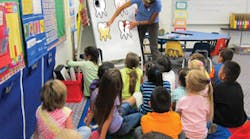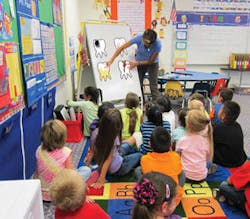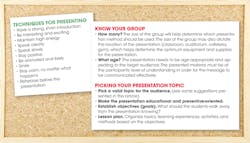The local school wants you to talk about oral health to students
by Tami Farmer, RDH, CDA
February is National Children's Dental Health Month. This is the month schools across the country focus on raising awareness about the importance of good oral health. This is the month hygienists are either excited about or dreading the inevitable call from a local school requesting a presentation for their students. Presentations do not have to be dreaded though. With a little planning, school presentations can be fun, easy, and something to look forward to each year.
Proper planning is the key element for a successful school presentation. Planning involves knowing the group that the presentation is meant for, picking an appropriate presentation topic, using proper presentation methods to convey the message, and following successful presentation techniques.
------------------------------------------------------------
Consider reading
------------------------------------------------------------
A poor presentation presents a barrier to learning. It is imperative to capture the group's attention and make them want to listen and learn. Following are three basic presentation method formats:
- Lecture. With a lecture format, a topic with many facts can be presented in a short amount of time. This is great for large groups. With this method, however, it can be hard to monitor if the students are grasping the concepts being introduced to them, because there is no active participation from everyone in the group.
- Lecture-demonstration. This method is good because the information from the lecture is supplemented by demonstrating skills or techniques. Visual learners absorb more with this method. However, it can be difficult to perform a demonstration to a large group so that everyone can see and hear the demonstration. It is imperative to have adequate facilities for a demonstration.
- Discussion. This presentation method works well with small groups of older children or teens. Discussion allows active participation and interaction among participants. The presenter can start out by asking questions to begin the group interaction. The presenter must have dynamic social skills to keep the discussion from failing.
A successful presentation is informative and successfully communicates an important message to the students. The students must be motivated to adopt successful behaviors that they can use every day, and to make informed decisions. Without motivation, learning is not achieved. Students learn well through active participation and involvement. This can occur during the presentation or after, if limited by group size or venue. Teachers can be provided with handouts, toothbrushes, activity pages, etc. for the students, to reinforce the presentation objective.
When giving a lecture or demonstration, proper audiovisual materials can help hold a group's attention. Many dental catalogues offer a wide variety of patient education materials. Visual aids include printed materials, pictures, charts, posters, flannel boards, bulletin boards, magnetic boards, models, puppets, mobiles, and computer media. If using audiovisual equipment, make sure the equipment is available in advance and that someone will be present that knows how to operate the equipment.
Sample topics for ages 4-6
Good oral health habits should start at an early age. It is important for presentations to have a positive impact on children and give them a good start on having healthy teeth and gums for a lifetime. With the younger age group, small group presentations work best. It is a good idea not to take questions, or to strictly use the discussion presentation method with this age group. The lecture-demonstration method works well with this group, who enjoys activities and playing games. Many of these children may never have been to a dentist, nor had dental topics presented to them.
Topics and objectives:
- Brushing (Why should you brush? How often should you brush?)
- Flossing (Why should you floss? How often should you floss?)
- Dental visits (What happens at a check-up? How often should you see a dentist?)
- Cavities (What is a cavity? What happens if I get one? How do I keep from getting one?)
- Healthy snacking (What foods are good and bad for my teeth?)
- Teeth (How many teeth do I have? When will I lose baby teeth?)
Demonstrations/activities:
- Look in children's mouths with disposable mouth mirrors and count teeth.
- Show a video on the selected topic.
- Read a book on the selected topic.
- Show dental tools (mirror, explorer).
- Put on a lab coat, mask, glasses, and gloves. Explain how they protect from germs.
- Play-Doh makes a Doctor Drill 'n Fill dental play set for young kids. They can make teeth and pretend to fill them. Consider using something like this for an activity.
- Use a puppet to show proper brushing/flossing techniques.
- Have three to five kids stand up, side by side, and use large rope as floss to show proper flossing technique.
- Show pictures of various foods, or bring various foods, and have children tell if they are a good food or bad food for teeth.
Sample topics for ages 7-12
Children in this age group have been introduced to basic dental concepts already. They are curious about more advanced dental concepts. Many have been to the dentist and had dental treatments. They may be curious about the treatments they have received. A lecture or lecture-demonstration presentation will work well with this age. Visual aids are important to capture the attention of this group. Have pictures or models that demonstrate the topic (sealant model, teeth molds, X-rays) for the children to see, touch, and hold.
Topics and objectives:
- X-rays (Why do I need them? What do they show?)
- Sealants (Do they keep you from getting cavities? What do they look like?)
- Getting numb (Do I have to get a shot? How does it feel being numb?)
- Fillings (What if I have a cavity and need a filling?)
- Braces (Do I need braces? What is it like to have braces?)
- Getting new teeth (How many permanent teeth? When do I lose all my baby teeth?)
- Dental emergencies (What if I'm playing and have a tooth knocked out?)
- Mouthguards (Do I need one when playing sports?)
Sample topics for teenagers
This group is interested in topics that affect them directly. A lecture with a large group or lecture and/or discussion with a smaller group work well with this age. This group is also thinking about what they want to do when they graduate and curious about various career options available.
Topics and objectives:
- Tobacco (Is it dangerous to your mouth? Why?)
- Oral cancer (What are the signs?)
- Wisdom teeth (What are they? Do they need to be pulled?)
- Bleaching (Can I bleach my teeth? How?)
- Oral health products (Which floss, toothbrush, toothpaste should I use?)
- Careers in dentistry (How long do you have to go to college? What is the average pay?)
Tami Farmer, CDA, RDH, is based in Rome, Ga. She can be contacted at [email protected].
Past RDH Issues








